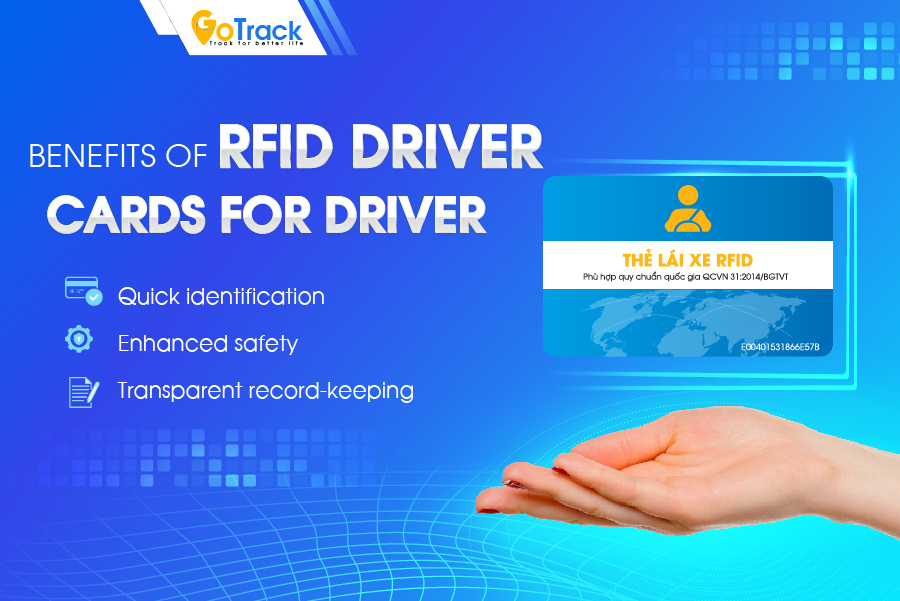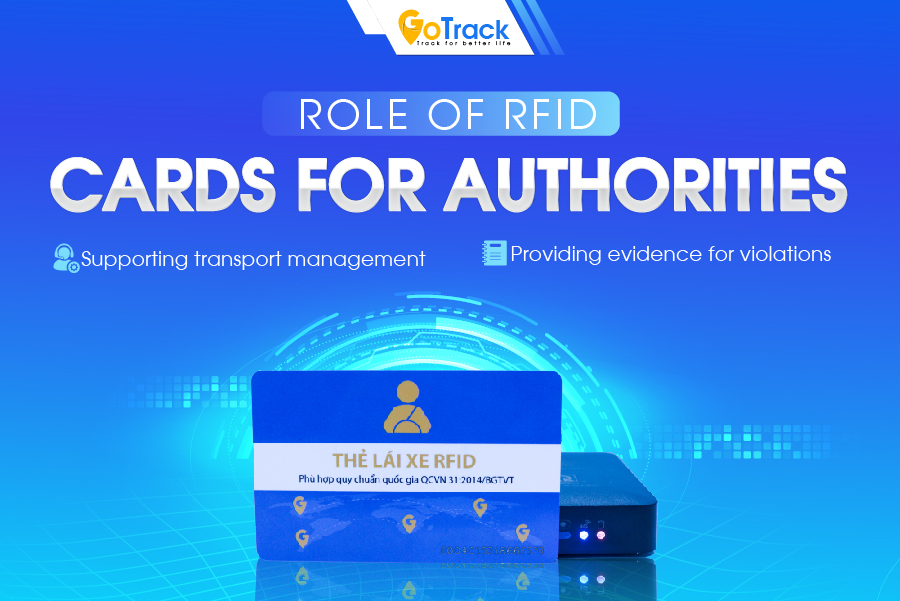As an essential part of a modern fleet tracking system, the RFID driver card provides vital support to transport companies and regulatory agencies. It enables companies to monitor the working hours of each driver, promotes safety, and offers authorities efficient tools to oversee and manage transportation operations.
Here, GoTrack will reveal the specifics and advantages of the RFID driver card.
What is an RFID driver card?
An RFID (Radio Frequency Identification) driver card is a specialized identification tool using radio frequency technology to record and recognize driver information automatically. The card typically includes the driver’s name, license number, and other relevant data. It’s compatible with all types of registered commercial vehicles, such as trucks, containers, passenger buses, and construction vehicles, making it versatile and applicable across various types of fleets.
Key benefits of the RFID driver card
For drivers
Quick and convenient identification: With the RFID driver card, drivers can seamlessly log in and out at the start and end of their shifts. This automation eliminates the need for manual timekeeping, a traditional method prone to errors and delays. The RFID system not only saves time but also increases accuracy, as it captures data instantly and precisely each time the card is used. By simplifying this process, the RFID card streamlines operations and enables drivers to focus more on their core tasks rather than administrative routines.

Enhanced safety and health assurance: Ensuring drivers work under safe conditions is essential in the transport industry, where long hours and fatigue can be major risk factors. The RFID driver card, integrated with tracking systems, enables the monitoring of drivers’ continuous working hours. When a driver drives for long hours, automatic alerts are sent to both the driver and fleet managers. This early warning system helps prevent driver fatigue, ensuring they operate at their best and reducing health risks associated with overwork.
Transparent record-keeping: Transparency is crucial in maintaining trust and clarity between drivers and employers. With an RFID driver card, drivers’ work hours are recorded automatically and stored in a secure digital format. This ensures there’s a reliable record of each driver’s work and rest times, which can be referred back to if any discrepancies or disputes arise. Such transparent record-keeping helps protect drivers’ rights, making it easier to calculate fair wages, bonuses, and other benefits, and providing documented evidence for handling work-related issues.
For transport businesses
Monitoring driver performance: Managing a large number of drivers can be challenging, especially when relying on manual tracking methods. With RFID cards, transport companies can monitor each driver’s activity in real-time, reducing the potential for discrepancies or fraudulent reporting of hours. This precise tracking minimizes human error and improves the accuracy of driver records, which are essential for making informed management decisions. By streamlining this aspect of fleet operations, companies save time and resources, focusing on productivity rather than administrative hurdles.
Read more: Driver management strategies for transport businesses
Improving fleet management efficiency: RFID driver cards, when linked with tracking systems, provide valuable data on each driver’s performance. Managers can monitor driving patterns, routes, and efficiency in real-time, allowing them to make adjustments as needed to optimize operations. This data-driven approach helps transport companies maintain a more efficient fleet, reducing costs and maximizing productivity.

Increased transparency and reduced fraud: Each RFID card is unique to the driver, meaning the data collected is highly personalized and accurate. This automatic data capture minimizes the need for manual input, reducing the risk of fraud or data manipulation. By limiting manual intervention, the RFID system ensures that managers can trust the data they see, facilitating quick responses to any violations or discrepancies. This level of transparency helps maintain a strong operational standard, encouraging adherence to guidelines and fostering accountability among drivers.
For regulatory authorities
Enhanced oversight of transportation activities: RFID driver cards not only support companies but also assist regulatory authorities in supervising transport activities. As each driver’s hours, rest periods, and routes are recorded in real-time, regulatory agencies can easily access this data without relying on physical paperwork or manual reporting. This automated, paper-free approach reduces the potential for errors, speeds up processing times, and cuts costs associated with manual auditing and record-keeping.

Reliable evidence for handling violations: One of the most significant benefits of RFID technology is its ability to provide accurate data on driver behavior, which is invaluable for regulatory compliance and public safety. Data on driver hours or safe driving practices can be collected and analyzed to identify and address violations. This accurate, verifiable information provides a reliable foundation for taking corrective actions, such as warnings or penalties for non-compliance. Furthermore, it enables authorities to take proactive steps to improve road safety, promoting a more secure and compliant transport industry.



